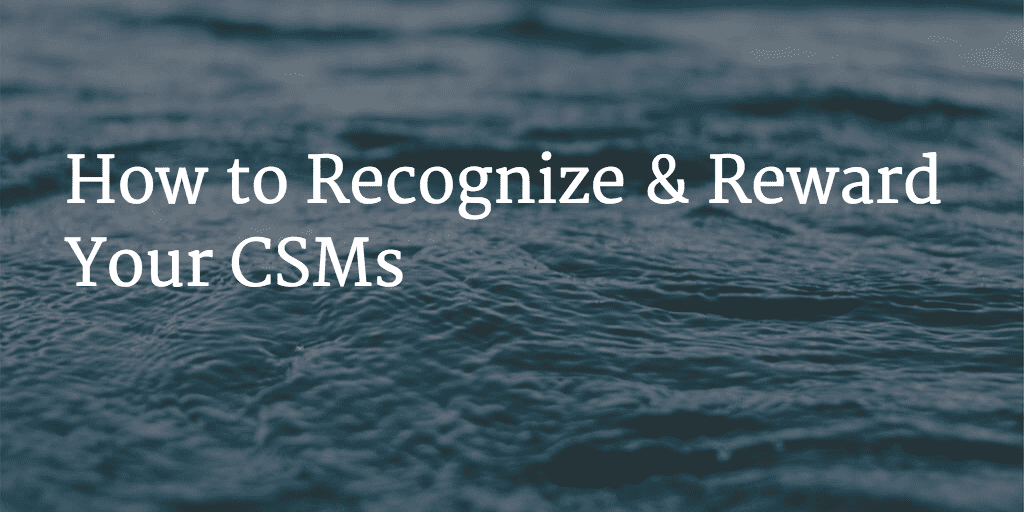Allison Pickens is VP of Customer Success & Business Operations at Gainsight
“Risk.” “Avoiding churn.” “Early warning signs.”
When your CSMs are talking about customers’ problems all day, it can take a toll on morale. Most CSM leaders want to make internal conversations more positive and celebrate all their achievements. Wouldn’t it be great if we could give our CSMs kudos more often?
There are a few barriers to this:
- If you’re a renewals-based business, then your renewals typically happen infrequently – maybe once a year for each customer.
- Upsells may not happen more than a few times a year.
- In large organizations, CSMs often aren’t directly responsible for closing the renewal. They may share credit with a renewals manager.
- Response rates to NPS surveys are often ~10%, and an executive at a given customer typically won’t submit more than two ratings per year.
- Many day-to-day CSM accomplishments are intangible or subjective, even if they are valuable – a productive meeting, the customer conveying a positive tone during a phone call, or a complimentary email.
- Compliments from the customer aren’t always indicators of success. They might love your CSM but hate your product.
- Even a secured renewal isn’t a strong measure of success. We all know customers who have renewed but aren’t using the product or won’t provide a reference.
Marketing gets kudos when they generate MQLs. Sales Development Reps take credit when they generate SQLs. What should CSMs take credit for?
I want a metric that is:
- Objectively valuable: No one can contest the achievement.
- A discrete unit: It’s clear when the achievement is complete.
- Measurable: We can create a Gainsight dashboard to track our achievements.
- Frequently achieved: We can recognize our achievements week-to-week.
- Attributable to the CSM: No one can contest that the CSM is primarily responsible.
Here’s what we came up with at Gainsight.
Net New Green Customers.
Specifically, customers that move from Red or Yellow to Green in our Habits Scorecard Measure. “Habits” is our term for adoption, since our goal is to encourage our customers to adopt good habits in using our product. (Note that Habits is one of our 8 Scorecard Measures described here)
We initially created a Habits Scorecard Measure that looks like this:
Green: At least x% of licensed users are daily active users of Cockpit (we took a 4-week rolling average)
- Yellow: Some usage, but not daily active users of Cockpit
- Red: No usage of Gainsight in the last week
We wanted to see many customers using Cockpit daily. Customers that do so have probably transformed their CSMs’ workflow. This process transformation is one important way to derive value from Gainsight.
That said, many customers who we knew used our product in a compelling way were in Yellow, grouped together with low-adopting customers. To accurately represent customers who were frequently using CoPilot, Customer360 dashboards, Gainsight Home, surveys, and other features, we created a fourth Habits level, called “Lime Green” (to show that this level is in between Green and Yellow):
- Lime: At least y% of licensed users are daily active users (of any part of the product)
So our current scorecard measure looks like this:
- Green: At least x% of licensed users are daily active users of Cockpit
- Lime: At least y% of licensed users are daily active users (of any part of the product)
- Yellow: Some usage, but not daily actives
- Red: No usage of Gainsight in the last week
The next step was to create a metric related to our Habits Scorecard Measure, to recognize the CSMs who boosted customers’ habits. We created a target for the quarter:
Move 20% of Yellow/Red customers to Green/Lime.
Then we can track weekly the percentage of customers that move into Green/Lime. We review the following dashboard in our weekly CSM Team Meeting on Tuesdays. (The following dashboards are all sanitized; they contain fake data.) I’ll want to see that we’re increasing the percentage in Green/Lime overall as a team each week.
We’ll then look at which customers moved between levels. The following dashboard shows customers that moved in the right direction:
And this dashboard shows customers that moved in the wrong direction:
In the chart below, you’ll see a stacked bar for every CSM, showing the percentage of that CSM’s customers that are in Green, Lime, Yellow, or Red at the beginning of the quarter. You can then create a similar chart to reveal the current percentages, by CSM, in order to showcase progress over time.
Note that customers that move in the wrong direction – e.g. from Lime to Yellow – count against the target, which is based on the net percentage of customers moved into Green/Lime.
Now, every Tuesday, I can congratulate my team members for new customers moved into Green or Lime! We even created a fun competition: we divided into teams that span customer segments, and the team with the highest achievement at end-of-quarter wins a margarita party (in honor of our new Lime level).
Here are other benefits to rolling out these targets:
- Accountability: Our CSM team is already accountable to our CEO and the board for boosting “habits” (strong adoption that indicates our customers are deriving value).
- Insight: Targets allow us to see if we’re improving on an important dimension, and inspire conversations on what’s working and what isn’t.
- Ownership: Give CSMs a sense of ownership and impact.
- Prioritization: Give CSMs and team leaders an ability to prioritize work based on attainment of targets.
- Significance: Having targets makes our investors and other execs recognize Customer Success as a function that is adding a ton of value. If we can say at the board meeting, “We made an additional 20% of our customers daily adopters last quarter,” our investors will take note. This might make a difference during budgetary conversations.
Here are some frequently asked questions about our targets system. If you choose to roll out a similar system to your team, your CSMs will probably ask you these questions, so I’d recommend creating an FAQ guide in advantage.
How should you define Green?
- Usage of a feature (or group of features) that signals the customer is deriving high ROI from your product.
- This feature is often (although not always) the stickiest part of your product.
Given that every customer is different, how can you come up with a universal definition of Green / Lime?
- It’s true that every customer is unique to some degree. One customer might be successful using your product but remain in Yellow. That said, it’s better to choose a metric that accurately represents the successfulness of 90% of your customers than have no metric at all.
How should you treat accounts that are still in onboarding?
- We’d suggest including only those customers that are in the CSMs’ scope of responsibility in the denominator.
How should you treat accounts that have already told us they’re going to churn?
- Mark them as “Will Churn” (which could be a Stage in your lifecycle) and exclude them from the denominator.
How should you treat customers that have a lot of licenses that aren’t being used (and thus may be difficult to move into Green or Lime)?
- This represents a major downsell risk, so I’d recommend working hard on moving this customer to Lime/Green.
How should you treat any accounts to be transitioned from one CSM to another this quarter?
- Set a deadline, at which point a CSM’s denominator will include all accounts that have already been transitioned to that CSM.
- Exclude any accounts that the CSM plans to transition to someone else later in the quarter.
- Offer extra credit (e.g. 3x the credit) for newly Green/Lime customers that have been transitioned to the CSM after the deadline.
How should you treat customers that are “never” going to be Green/Lime because of organizational challenges (e.g. re-orgs, etc.)?
- You should still include them in the denominator since this question contains a subjective assessment, and since offering too many exceptions will erode the integrity of the target. That said, this is a good opportunity to help your CSMs prioritize. You might want to have them spend more of their time on the customers that have potential.
How should these targets apply in a Pooled CSM model, where CSMs don’t own accounts but instead share them?
- Create a group target in this case, rather than a target for each individual CSM.
- In our case, for this quarter, we’re treating Green and Lime the same way. You could choose to treat them differently: e.g. you could give 2x the credit for a new Green customer and 1x the credit for a new Lime customer.
How should the target affect CSMs’ bonuses?
___
If you need help with the rules and reporting shown here, please respond to this email. We’re going to gauge interest in a webinar on this topic. You can follow Allison’s blog posts on Twitter at @PickensAllison. She also appreciates your comments on her posts, so you’re welcome to email her at apickens@gainsight.com.






